

|
|
 |
 |
 |
 |
// Источник: B.A.F. Newsletter,
Декабрь 2001, No 40
Important points in
SHOMEN-UCHI DAI IKKYO
(Suwari-Waza)
Demonstrated and explained by
Kanetsuka Sensei
|
|

Photos and text: Peter Megann
Graphics and typesetting: Graham and Laura Jones
Uke: Richard Martin
|
Omote
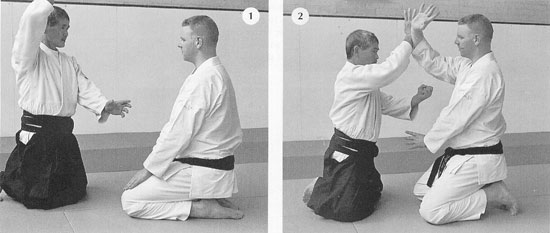
|
Photo 1: In the omote form of Ikkyo it is Tori who takes the initiative by making a strike at Uke's head. Note that if the ma-ai is not so great between Tori and Uke there is no need for Tori to take a (knee) step forward at he makes shomen-uchi at Uke's forehead. Tori's action causes Uke to raise his right hand to protect himself. |
|
Photo 2: As Tori's hand descends towards Uke's head. Tori's weight comes onto his right knee as he slides it slightly forward to the right, keeping a strong feeling in the toes. |
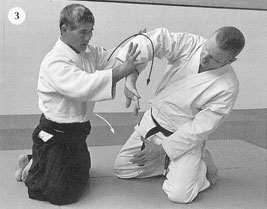 |
|
Photo 3: Tori's right te-gatana (hand-blade) is cutting down, while his left hand rises with a feeling of atemi towards Uke's armpit and head and makes contact with the under part of Uke's upper arm just above the elbow. He is not actually gripping at this moment; just cupping Tori's arm with the palm and little finger of his left hand. Tori's whole body is moving forward and to the right. Two important points at this stage: (a) Do not try to grip your partner's right wrist (a common mistake). If you do, you will bend your elbow and your attack will be weakened. (b) Don't push your partner away from you. Keep him at a distance where you can control him without losing your centre. Your energy should flow strongly from your big toes as you make kiza. Keep your back straight; don't lean forwards. As you cut down, your right hand
makes a small circle and your left hand makes a large circle as
your body turns to the right.
|
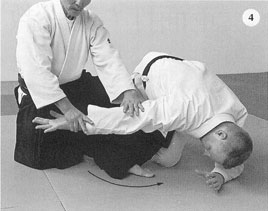 |
|
Photo 4: As Uke loses his balance, Tori 'chases' him by bringing his left foot forward. At the same time he grips Uke's wrist gently with his palm and little finger (no need for a strong grip).
|
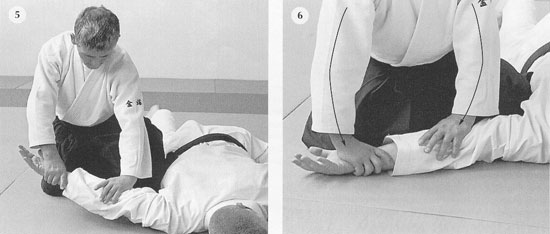 |
Photo 5: Tori maintains his control of Uke through the position of his centre of gravity rather than by using arm strength. It is important to maintain good balance through the stages of Photos 4 and 5. |
|
Photo 6: Tori's left knee conies down to the tatami near Uke's armpit and his right knee moves forward to a point near Uke's wrist, inside his gripping hand. At this point Uke's arm should be lying at about 105° from his body (certainly more than 90°). |
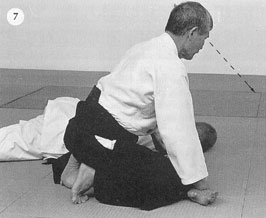 |
|
Photo 7: As Tori pins Uke's arm, he maintains a good posture, sitting in kiza and keeping a straight back, his feet (together) and his knees forming a triangle. Don't rise up off your heels at this point. The inside of your partner's elbow should be in contact with the tatami. Relax your shoulders and arms, and keep your armpits closed (though not tightly). Keeping your centre of gravity low, shift your weight with a rocking feeling onto your partner's elbow and wrist, as you breathe out. Don't push down on your partner: simply settle your weight down onto his arm. Don't look down but look at a point about a metre in front of you.
|
Ura |
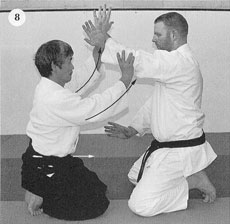 Photo 8: As Uke makes a shomen-uchi strike against Tori's head, Tori rises up into kiza. His left hand floats up to engage Uke's striking hand with te-gatana (DO NOT GRASP THE WRIST). Note that Tori's left wrist is rotating at this point - as in the suwari-waza kokyu-ho exercise - so that the thumb is pointing towards Tori's forehead, his left elbow slightly expanding outwards as it moves towards Uke. The left arm is not held stiffly outwards towards Uke but rises in an arc. The feeling is that of making a strike at Uke's forehead. Like the left elbow the right elbow is expanding slightly outwards. (Notice again the similarity with the movement of the arms in the suwari-waza kokyu-ho exercise.) At the same moment Tori's right hand floats up to meet Uke's arm just above his elbow, making contact with a cupping action (see text for Photo 3). The action of both arms in unison is similar to the action of defending your head (furi-kaburi) in sword-work. Do not push against your partner during this action. There should be a feeling of 'dropping' in your elbows. Your centre is advancing with energy flowing upwards from your toes; your knees have not yet moved.
Photo 8: As Uke makes a shomen-uchi strike against Tori's head, Tori rises up into kiza. His left hand floats up to engage Uke's striking hand with te-gatana (DO NOT GRASP THE WRIST). Note that Tori's left wrist is rotating at this point - as in the suwari-waza kokyu-ho exercise - so that the thumb is pointing towards Tori's forehead, his left elbow slightly expanding outwards as it moves towards Uke. The left arm is not held stiffly outwards towards Uke but rises in an arc. The feeling is that of making a strike at Uke's forehead. Like the left elbow the right elbow is expanding slightly outwards. (Notice again the similarity with the movement of the arms in the suwari-waza kokyu-ho exercise.) At the same moment Tori's right hand floats up to meet Uke's arm just above his elbow, making contact with a cupping action (see text for Photo 3). The action of both arms in unison is similar to the action of defending your head (furi-kaburi) in sword-work. Do not push against your partner during this action. There should be a feeling of 'dropping' in your elbows. Your centre is advancing with energy flowing upwards from your toes; your knees have not yet moved.
|
Photos 9-12: Tori slides his right knee slightly forwards to a point just in front of Uke's left knee. Keeping his feet together he pivots on his right knee, his whole body turning to the left as he draws his left knee backwards in a large arc. Be careful not to pull your partner during this tenkan movement. You must bring your partner around you in a spiral movement. His arm must always be in front of your centre. Your partner should be as if floating in front of you. A stable, square-like feeling must be maintained
throughout the whole of the tenkan. As you begin to turn, rotate your hand-blade (thumb turning downwards) to deflect your partner's power. The shape of your arms should remain constant (they should remain extended). Your right hand is pointing to the left and is at a point in line with your navel. Your left hand is leading to a point just beyond your left hip. Don't grip too soon or your arras will straighten and your wrists will roll over outwards. Rather, your wrists should be depressed so that your hands form an angle with your forearms such as when you place your hands on the tatami when you begin to make z.a-rei (Photo 12). Keep your arms in a horizontal position and maintain the same pressure on your partner's arm. Don't use too much physical force: just keep contact with your partner's arm. If you keep good ma-ai. move smoothly, keep a correct relationship and don't force the movement, your partner will almost fly through the air. This is why the study of kokyu is important. You should make one
unbroken sweeping movement with energy flowing from your toes to your palms.
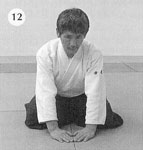
|
|
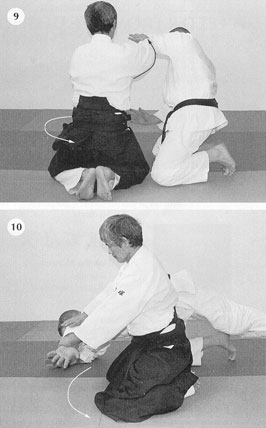
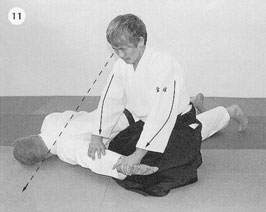
|
|
Photos 13 & 14: The pin is the same as in Photos 6 & 7.

|
|
To conform with the standard terminology of Aikido techniques found in Hombu publications we are now calling
ikkyo, nikyo, sankyo, etc, dai ikkyo, dai nikyo, dai sankyo, etc., where
dai might be translated as 'number' (i.e. 'number one', 'number two', 'number three', etc.)
|
|
 |
| |
|
 |
  |
 |
